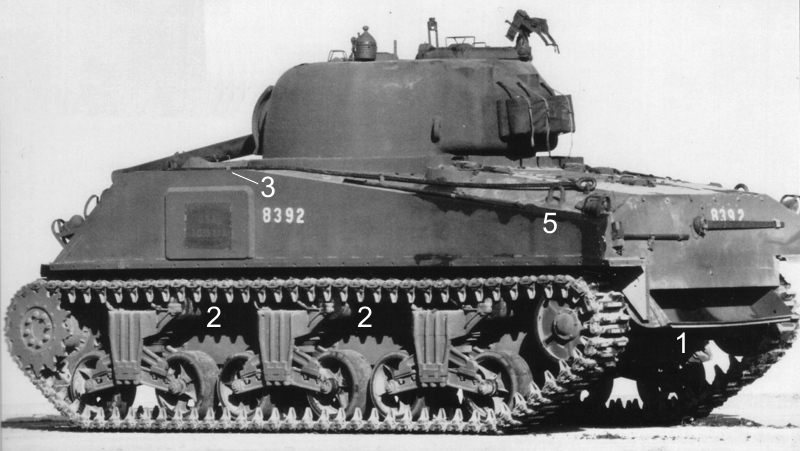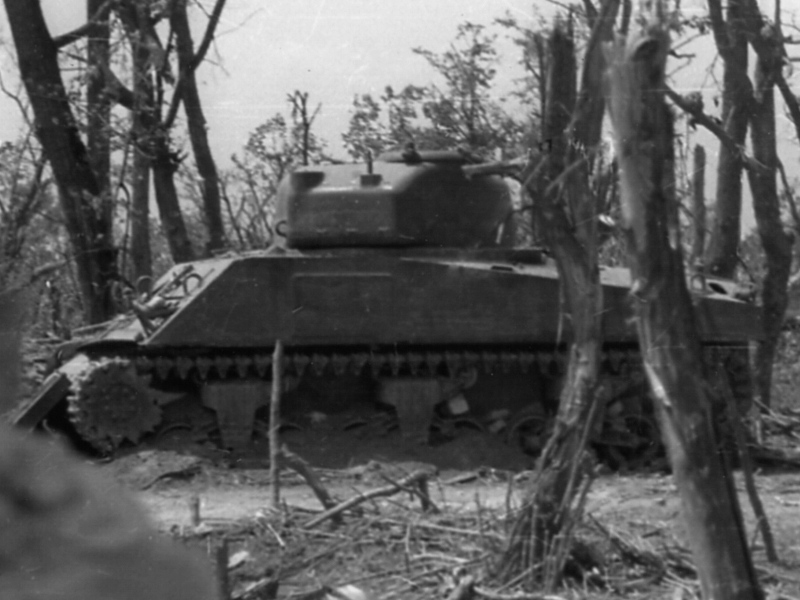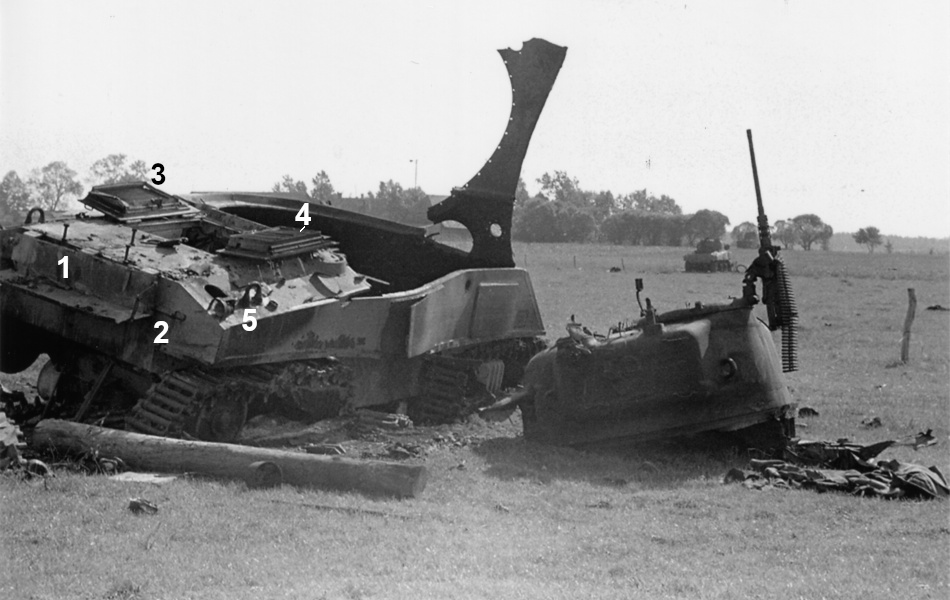
Above shows another combat casualty filmed by the Germans sometime
in 1944. They appear to have employed demolition charges in order to
deny its recovery by the Soviets. A new addition that can be seen on
this unit is the blanket roll rack (1). It may have been added at a Tank
Depot, but we suspect it was factory installed, as the builders had
priority when it came to the introduction of modifications. The
commencement date for installation on the M4A2 is listed in an Ordnance
Department document as 3/27/44. We cannot verify this, but if true, it
would have been on perhaps the last 150 M4A2(75)s. The tools (2) are
"still" mounted in their original position on the upper rear hull plate.
Note the appearance of the underside of the M4A2 engine deck doors. The
left-side door (3) has been damaged, but the right door (4) has what we
think was a "box" with shutters retrofitted. Note that this unit has
the "standard" hull lifting rings (5) in the rear.

Another large hatch M4A2(75)
with high bustle turret KO'd on the Eastern front. The improved, Barber-Colman
louvered type of exhaust deflector (1) can be compared to the initial sheet
metal type shown earlier. This was mandated to be factory installed starting
January 1, 1944. Note that, on this example, the track wrench (2) and sledge
hammer (3) have been relocated from their original positions on the upper rear
hull plate to the rear of the engine deck. This would suggest a factory
installation of the blanket roll rack, a standard second generation Sherman
fixture. The repositioned tools would have permitted the installation of the
the spare track holders, also second generation standard, but they are not
installed. Both of these items were present from the start of Fisher's M4A3(75)
Wet production in February 1944.
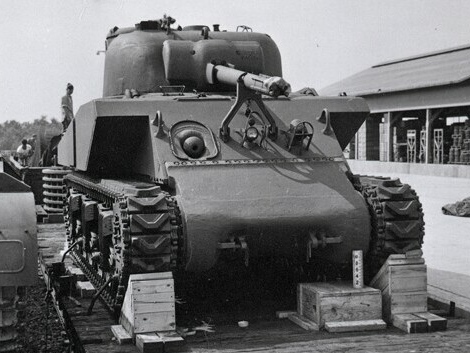

It has been difficult to
"count heads" on the large hatch M4A2(75)s since most of them
"disappeared" to Soviet Lend Lease. Very few were evaluated by the
Government or used as test vehicles. We showed the T6 Floatation Device pilot
earlier. Another was used as a platform for the Mine Exploder T10. Fisher Body
handled the project, and the above shows the appearance of the vehicle as it
arrived at Aberdeen Proving Ground in May 1944. The massive rollers can be seen
just behind the tank. Unfortunately, this was one of the few APG Reports we
encountered that did not list the serial number of the tank. As with our
previous Soviet example, and unlike Serial Number 47564 shown earlier, this
unit can be seen to have the blanket roll rack and repositioned tools.


The T10 was tested at APG in
June 1944. Captain Merritt D. Elliott reported "The vehicle, to date, has
not been too successful due to the fact that only the front two rollers are
powered, and the rolling resistance of the rear roller, which is unpowered,
tends to cause the vehicle to get stuck." Perhaps with his tongue in cheek
regarding the outlandish appearance of the tank, Elliott wrote, "From all
indications, it seems the Ordnance Department is making any and every kind of
device to remove mines." This was the only pilot, and the T10 project was
abandoned shortly thereafter.

It is thought that the large
hatch M4A2(75) made its combat debut with the Marine Corps in June, 1944 at
Saipan. Photos show them serving there alongside small hatch M4A2s with both
the 2nd and 4th Marine Tank Battalions. After Tarawa, the USMC "got
religion" when it came to waterproofing their tanks. In some cases, the
Marines fashioned their own wading trunk designs, but the unit shown above
appears to have been equipped with the "official" version, made
available in kit form in early 1944. Preparing a Sherman for deep water fording
was a laborious undertaking. According to the Technical Manual, if the job was
done properly, the tank would be able to operate in water up to 6 feet for all
of 8 minutes. This 4th Tank Battalion Sherman appears to have fallen into a
shell hole in the surf, which drowned out the engines. Marine large hatch M4A2s
and M4A3s can be difficult to distinguish, but a bit of the side applique
(circled in red) can be seen here. The M4A3s were not equipped with the
applique plates, since they were "Wet Stowage" tanks in which the
ammunition bins had been repositioned to the floor of the vehicle.
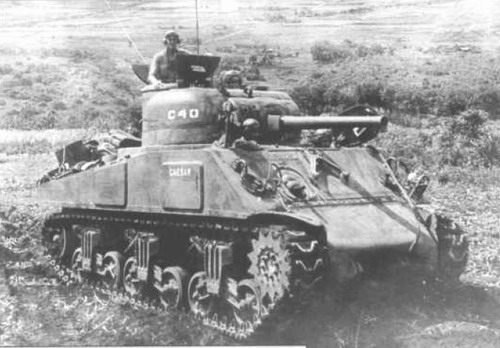
According
to author Romain Cansiere, the US Marine Corps' original decision to
use the M4A2(75) as its Main Battle Tank had nothing to do with diesel
fuel. Rather, the type was "the first one the Corps could obtain quickly
in large numbers" from the limited supply of Medium Tanks available in
late 1942, early 1943. Furthermore,
we suspect that requisitions may have stipulated Fisher built M4A2(75)s
exclusively, as we have yet to see a photo of a USMC M4A2 produced by
another manufacturer. They are stated to have received a total of 493
units. Since
no official distinction was made between the small and large hatch
models, it has not been possible to determine the exact number of large
hatch M4A2(75)s they received. At present, our guess is around 200.
"Caesar" of the 2nd Marine Tank Battalion was photographed on Tinian on
August 1, 1944. This unit appears to be nearly "as built." Fisher Body
ended M4A2(75) production with the commander's split hatch as seen here.
Priority for the limited supply of all-round vision cupolas was given
to the 76mm Shermans which began to roll off the production lines in
January 1944. The new cupolas did not become available for use on the
M4A3(75)W until August 1944.

 The left side photo shows a
tank of Company A, 1st Tank Battalion progressing on Peleliu airfield on
September 15, 1944. The glacis and turret sides have been "up
armored" with spare tracks. The right side photo shows an M4A2(75) with M1
Dozer blade. The Marines considered themselves to be "last in line"
when it came to the issuance of new equipment, but they did manage to procure
supplies of this very effective addition to the Sherman.
The left side photo shows a
tank of Company A, 1st Tank Battalion progressing on Peleliu airfield on
September 15, 1944. The glacis and turret sides have been "up
armored" with spare tracks. The right side photo shows an M4A2(75) with M1
Dozer blade. The Marines considered themselves to be "last in line"
when it came to the issuance of new equipment, but they did manage to procure
supplies of this very effective addition to the Sherman.
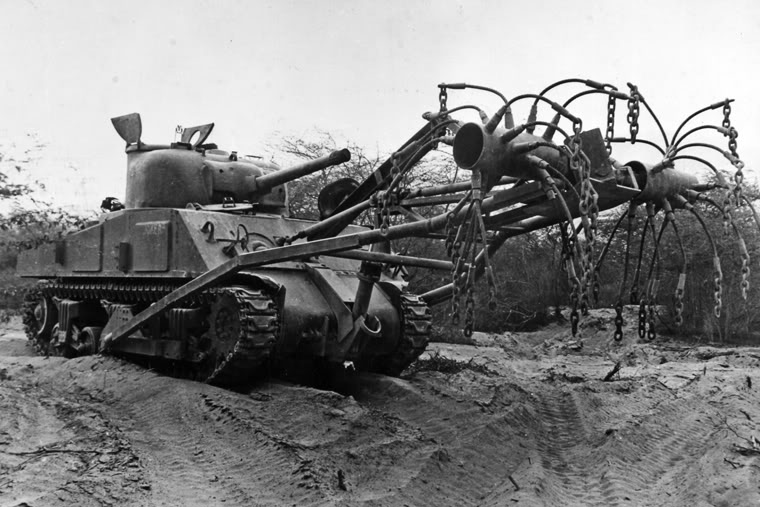 This M4A2 named
"Joker II" is said to have served with the 4th Tank Battalion on Saipan.
When the battalion was reequipped with the M4A3(75)W, this spare unit was field
converted to a mine flail. Photos of British Crab tanks were used as reference,
and the flail was created from truck parts and other odds and ends. It was
brought to Iwo Jima, but, like the T10 featured earlier, was "not too
successful," as it got bogged down in the soft, volcanic soil
This M4A2 named
"Joker II" is said to have served with the 4th Tank Battalion on Saipan.
When the battalion was reequipped with the M4A3(75)W, this spare unit was field
converted to a mine flail. Photos of British Crab tanks were used as reference,
and the flail was created from truck parts and other odds and ends. It was
brought to Iwo Jima, but, like the T10 featured earlier, was "not too
successful," as it got bogged down in the soft, volcanic soil

The US Army wanted to
terminate production of 75mm Shermans at the end of 1943. However, it was
recorded that the British and the USMC did not desire the 76mm Sherman, and
would require 75mm models into 1945. Thus, the Government decided to continue
production of a single model - the M4A3(75)W. One bit of intrigue in this
matter, not for "foreign" consumption, was that Ford engined Shermans
were to be reserved exclusively for use by US troops. Despite some objections,
the policy more or less forced the USMC to accept gasoline powered Shermans
after the middle of 1944. Thus, the new 6th Marine Tank Battalion was equipped
with the M4A3(75)W for the Okinawa Campaign, while the veteran 1st Tank
Battalion came ashore with 47 M4A2s, most or all of which appear to have been
large hatch models. The unit shown above was photographed on April 4, 1945. By
late 1944, modification kits became more readily available, and the Corps was
able to obtain supplies of the commander's vision cupola (1) and the extended
end connectors (inset) that can be seen on this tank.

Okinawa was "the last battle," and tank casualties were fearsome. The
1st Tank Battalion had to draw some M4A3s from the replacement pool
when its reserves of M4A2s ran out. The unit shown above was reported
to have been destroyed by a mine in mid-June 1945. This tank can be
identified as an M4A2 by the sections of the engine deck that can be
seen. (The inset shows a 6th USMC TB M4A3 for comparison.) For future
reference, note the triangular shaped object on the engine access door
(1). Counting heads suggests that the sheet metal cover over the
ventilator (2) was not introduced at Fisher until July 1944 a few
months after M4A2(75) production had ended. A close examination of this
and the preceding photo show "padded" hull lifting rings in the rear
(3). Fisher was building several Sherman models at the same time, but
so far, we have not come across any examples of these on an M4A3(75)W,
M4A3E2 or M4A2(76).

In the Spring of
1944, Lima Locomotive Works converted 12 large hatch M4A2s to M32B2 Tank
Recovery Vehicles for USMC use. In the 3rd Marine Division photo above, the
absence of the ventilator beside the driver’s hatch confirms
that this is a large hatch Sherman. Lima also converted 20 large
hatch M4A3(75)Ws to M32B3s for the Marines. Since this retriever does not have
the typical M4A2 appliqué plate, it would be a challenge to distinguish
from an M32B3 it if it weren't for the "M32B2, Lima Locomotive Works"
stenciling. A single "M4A2" ID clue is provided by the grouser compartment cover
(1), which was not installed on M4A3s. It is thought that a few of the
large hatch M32B2s were used by the Marines in combat in 1945.

We
like to examine surviving Shermans as part of our research. A bit of
one is on display at the National Military Museum in Bucharest, Romania.
This tank is reported to have fallen into the Prut River near Petresti
in August 1944. Shortly thereafter, Russian forces recovered the turret,
presumably for refitting to another Sherman. A local who was granted
permission to salvage the engine, appears to have salvaged a good deal
more than that. What was left was recovered in 2000, and placed on
displayed at the museum. While the serial number of this tank is not
known at present, the forward cable clamp can be seen in the "first"
position (1). It should be noted that the cable clamp is welded on to
the E8020 casting. Thus the first or "early" position of the clamp on
Fisher large hatch M4A2(75)s differs from the early position seen on
Chrysler M4/M4A3(105)s and M4A3(76)s produced up to July, 1944. Chrysler
welded the clamp on to the armor plate behind the E8020 piece. In any
case, the early position of the forward cable clamp, along with the
straight as opposed to upturned return roller arms, would lead us to
judge that this example was produced in late 1943. Information and photo
courtesy of Doug
Kibbey.
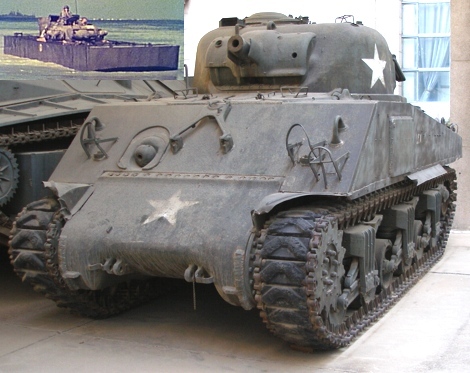

The
other known surviving large hatch M4A2(75) is more intact, but lacked
its main gun when these photos were taken. It is displayed at the
People's Revolution Museum in Beijing, and as yet the Serial Number is
not known. Perhaps this tank served Occupation Duty in China with the
1st Marine Tank Battalion, and was left behind as unserviceable when
they pulled out in 1947? Note that this example has the the
forward cable clamp in the "standard position," but "still"
has "padded" hull lifting rings on the rear. It appears to
have the fittings for the Barber-Colman type exhaust deflector on
the rear hull plate, which was ordered to be installed starting on
January 1, 1944. The bogie units are the final type with upturned
return roller arms, and we would observe in passing that the right
rear bogie has the date "12-43" cast in. It can be seen to have
been retrofitted with the commander's all round vision
cupola. Various weld scars hint that this tank was outfitted with
the T6 Floatation Device. A few Marine units on Okinawa
(including the 1st Tank Battalion) swam ashore with some T6 equipped
Shermans (inset). Maybe this M4A2 was one of them? Photos courtesy of
Ley Reynolds.


Small changes were
incorporated by Fisher during the course of production. These have been easier
to study on M4A3s, but we think it is safe to assume the M4A2s followed a
similar course. We would emphasize that these changes were transitional; that
is, it could take a month or so before a new feature completely replaced an
older one on the production line. The large hatch M4A2(75)s and some of the
first M4A2(76)s manufactured in May 1944 had what the authors think of as the
"early" glacis pattern. This pattern featured inboard hull lifting
rings and "long" bullet splashes in front of the drivers' auxiliary
periscopes (circled in red). The top edge of the glacis plate was neatly
beveled.


Fisher transitioned to the
"mid" glacis pattern in May, 1944. The bullet splashes were
shortened, and perhaps as a labor saving measure, the top edge of the glacis
plate was no longer beveled, but simply square cut. In August, 1944, the hull
lifting rings were relocated to the edges of the glacis. We think of this as
the late or final glacis pattern. Both photos courtesy of Jim Goetz.


The
earliest large hatch M4A2s were made with two small weep holes in the
rear of the turret splash. The photo on the left above shows a Fisher
M4A3(75)W, since we haven't as yet had the opportunity to examine and
photograph one of the few surviving large hatch M4A2(75)s. It was found
that the small holes could become clogged with debris, causing water to
back up and foul the gasoline supply of the auxiliary generator. It was
thought that a single, large hole would alleviate the problem. This
transition took place starting in July 1944. Some of the earliest
Chrysler built large hatch M4s and M4A3s with 105mm guns had the gap
between the turret splash and the fuel cap bullet splash filled in by
welding. We have seen no evidence of this practice on Fisher large hatch
Shermans. For future reference, note the subtle difference in the
shapes of the bullet splashes (1 & 2) protecting the armored filler
caps.


Fisher seems to have used just
about every type of road wheel on the Shermans it produced in 1944. In the
early months, units were equipped with either the welded spoke (A) or pressed
spoke wheels (B). The welded spoke with "small holes" (C) and the
solid, concave wheels (D) were introduced in Summer 1944, and appear to have
been prevalent by the Fall.

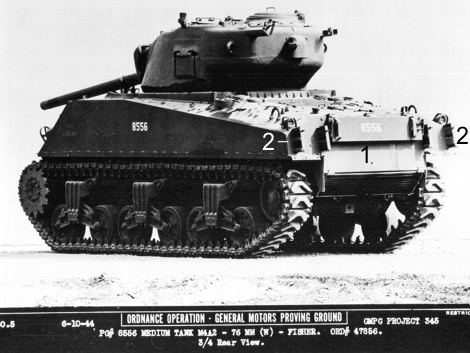 M4A2(75)production ended and
M4A2(76) production commenced at Fisher Body in May 1944. The thirteenth unit
(Serial Number 47856, USA 3080453) was evaluated at the General Motors Proving
Ground in June. The tank can be seen to have the "early glacis pattern"
as explained above. Production started with the D82081 turret with the loader's
split hatch. While the gun appears to be the "unthreaded" M1A1, we
suspect it might actually be the threaded M1A1C without the protective collar.
Government documents have it that only the first 385 "medium tanks M4
series (76mm gun)" were equipped with M1A1s, and we think the supply of
these may have been exhausted before Fisher began production. The rear view shows fittings
for the gun cleaning rod mounted on the blanket roll rack (1), as well as the
spare track holders (2). These items are not seen in the few period
photos of large hatch M4A2(75)s. Note that the crowbar fittings
(3) are "back" in their original position with the
other pioneer tools on the right rear. The crowbar is seen mounted by
itself on the left sponson in the few period photos of large hatch M4A2(75)s.
M4A2(75)production ended and
M4A2(76) production commenced at Fisher Body in May 1944. The thirteenth unit
(Serial Number 47856, USA 3080453) was evaluated at the General Motors Proving
Ground in June. The tank can be seen to have the "early glacis pattern"
as explained above. Production started with the D82081 turret with the loader's
split hatch. While the gun appears to be the "unthreaded" M1A1, we
suspect it might actually be the threaded M1A1C without the protective collar.
Government documents have it that only the first 385 "medium tanks M4
series (76mm gun)" were equipped with M1A1s, and we think the supply of
these may have been exhausted before Fisher began production. The rear view shows fittings
for the gun cleaning rod mounted on the blanket roll rack (1), as well as the
spare track holders (2). These items are not seen in the few period
photos of large hatch M4A2(75)s. Note that the crowbar fittings
(3) are "back" in their original position with the
other pioneer tools on the right rear. The crowbar is seen mounted by
itself on the left sponson in the few period photos of large hatch M4A2(75)s.

At first, M4A2(76) production
was earmarked entirely for Soviet Lend Lease. The Fourth Russian Protocol ran
from July 1944 through June 31, 1945 and called for the delivery of 3000
M4A2(76)s. To make up for the 200 unit shortfall of M4A2(75)s shipped, the US
"frontloaded" the Protocol. In May 1944, the 30 M4A2(76)s produced in
that month were allocated to the Soviets; and in June, 198 (sic) of the 195
produced in that month were allocated to them as well. Yuri Pasholok, author of
the webpage [translated as] “Emcha with a long gun”, reports that the first
M4A2(76)s were shipped by way of the “Southern Route” to Iran, and arrived in
Baku on the Caspian Sea in late September, 1944. The 1st Mechanized Corps is
said to have been the first to receive the new “long gun” Shermans starting in
October, 1944. The photos above show an August 1944 production M4A2(76), USA
3081179 which was the subject of a Soviet Evaluation Report at Gorokhovets
Artillery Range. Based on the forward position of the loader’s periscope
(inset), we suspect that this unit was one of the very first M4A2(76)s to
incorporate the new D7054366 turret with oval loader's hatch, as well as the
late glacis pattern with the “outboard” hull lifting rings. Also seen is the
sheet metal cover over the ventilator, introduced on Fisher M4A3s starting in
July, 1944. Most of the other published photos of M4A2(76)s are dated Spring or
Summer, 1945. However, first combat appears to have occurred in late 1944. Soviet
records indicate that units of the 9th Guards Mechanized Corps reported losses
of M4A2(76)s starting December 5, 1944. Photos courtesy of Yuri Pasholok.

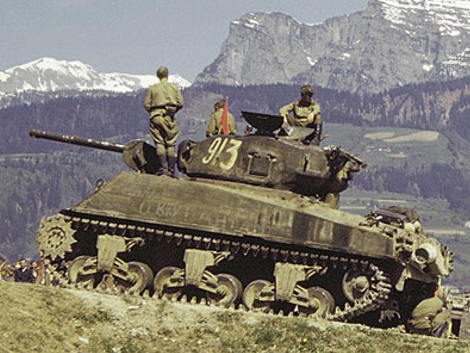
These photos show the same
M4A2(76), Number 913 of the
9th Guards Tank Brigade. US Signal Corps
photographers stationed near Leizen, Austria filmed the tank on two
separate
occasions in May and June 1945. The caption of the black and white
photo is one
of the few of the period that describes it as "a Sherman Tank." Again
we see the late glacis pattern with the outboard lifting rings, thought
to have
been introduced at Fisher around August 1944. Curiously, this tank does
not
have the rear view mirror fittings, seen on Fisher Shermans starting in
May.
Unlike 3081179 from the previous caption, this tank is "still"
equipped with the older D82081 turret with the loader's split hatch.
The
concave type road wheels seen on this tank were introduced by Fisher
along with
the welded, "small holes" type beginning in the Summer of 1944. Note
the cap with retaining chain over the 2 inch smoke mortar
sleeve. Extended end connectors are conspicuous by their absence
in photos of Soviet Shermans. According to Lend Lease records, the
Soviets weren't officially charged for any EECs, while the
"British Empire" was charged for nearly 600,000.
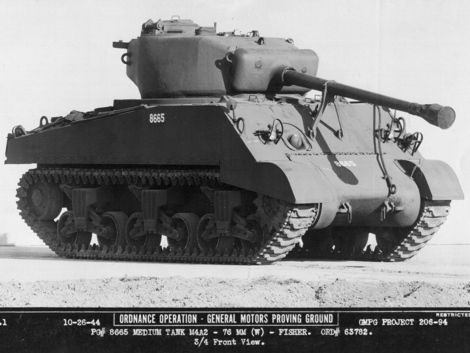

Serial Number 63782, USA
30116804 was accepted in October 1944, and evaluated at the General Motors
Proving Ground later that same month. We estimate that this would have been
about the point where the transition to the D7054366 turret with oval loader's
hatch, and the M1A2 gun with muzzle brake was completed. The road wheels are
the welded, "small holes" type. The rear view mirrors are rarely seen
installed on anything but test tanks. Earlier we pointed out the triangular
shaped pull seen on the engine access door of a USMC large hatch M4A2(75). One
can catch a glimpse of these in the rear photo. The "Lift Here"
stencils were added because some stevedores didn't trust that the hull lifting
rings could hold the tank's weight. Their alternate hoisting methods often
resulted in serious damage, particularly to the suspension components.

This well known photo, dated
May 3, 1945, was taken in Grabow, Germany by a Signal Corps photographer
"embedded" with the 82nd Airborne Division. The caption writer must
not have known his tanks, since he did not identify this as a Lend Lease, American
built vehicle as one might expect. Fisher's custom was to paint on the USA
Number real small in blue drab (1). Unfortunately, it was not possible to get a
good read of it despite a magnifying glass examination of the original glossy
print at the US Archives. However, bits of the shipping code (2) could be read,
and this tank was part of the December 1944 Lend Lease allocation for 199 units
- "SR [Sequence Requisition] 13601." The Soviets asked that the tanks
be shipped filled with Lend Lease Diesel, and despite some stevedore and
Merchant Marine objections, this was done, as can be seen in the stencil (3)
"FUEL TANK 3/4 FULL." The dark glue spot (4) was for Tank Depot
"Modification Records Here." Some of the shipping stencils can be
seen to be in Cyrillic. These provide instructions regarding the engine coolant
mixture, and battery handling under extremely cold conditions. With thanks to Alexander Gladchenkov.

Many Soviet Lend Lease Shermans can be seen to have had some of the shipping stencils painted on in Cyrillic. Researcher Alexander Gladchenkov has provided the translation which follows:
Attention
engine cooling system is primed
antifreeze protection against freezing
at -40 ° C (minus 40 ° Celsius)
(60% ethylene glycol and 40% water)
(missing word) dry charging type for start-up
For implementation remove cap
and vent plugs and pour electrolyte
density 1.275
At a temperature of -20 ° C minus 20 ° Celsius) and below
Demanding recharging for 6-12 hours
8 amperes to protect the
battery from freezing.

This tank is currently
displayed at the Museum of Military Air Forces of the Northern Fleet in
Safonovo, Murmansk Oblast. A correspondent reported
that it is Serial Number 64465, which makes it late December, 1944 production.
We think that Fisher made the transition to HVSS at around SN 64469, so this
tank would be one of the very last M4A2s produced with VVSS. Unlike 3081179
shown earlier, this tank was shipped by the “Northern Route.” It was salvaged
in July, 2014 from the wreck of the SS Thomas Donaldson, a Liberty Ship sunk
in the Barents Sea on March 20, 1945 by U-boat U-968. Another M4A2(76)VVSS was
recovered from the same ship in 2016, and is currently displayed in
Saint-Petersburg. In the interest of historical accuracy, we would note that,
in 2017, it was reported that SN 64465 was restored to running condition. Due
to the poor condition of the VVSS components and missing tracks, the tank was
retrofitted with HVSS suspension from a turretless Soviet M4A2 tractor
conversion when it was restored to running condition. With thanks to Dmitry Ukryukov.

It
is thought that Fisher Body completed the transition to HVSS on its
M4A2(76)s on January 1, 1945. While official documentation has yet to be
found, we calculate that Fisher produced at least 1299 units. The
Soviets were the primary Lend Lease recipient of the M4A2(76) at 2073
units. The British are reported to have received 5 in the second half of
1945; that is, after VE Day. All of these are believed to have had
HVSS. We estimate that the Soviets got about 460 M4A2(76)HVSS. According
to an article by Yuri Pasholok (alternate link), the
first 34 units with HVSS were reported to have entered the Soviet Union
by the “Northern Route” in March 1945 as part of Convoy JW-65. Most of
the M4A2s from this convoy, including 33 with HVSS, were dispatched to
the Gorky ABT Center for processing before issue. The Sherman shown
above was reported as USA 30122430. It had been unloaded in Murmansk
from the Liberty Ship Eleazar Lord, and delivered to
the Soviet Test Facility at Kubinka, where a 1000-kilometer test of the
“M4A2-76mm with a modernized chassis” commenced in early April 1945. There
is no photographic evidence of Soviet M4A2(76)s with HVSS in combat in
the final days of the war in Europe. This appears to be because none had
been processed and authorized for issue before V-E Day, which was 9 May 1945 in the Soviet Union.
 Some M4A2(76)HVSS’s
appear to have been delivered to ports in Asia before Lend Lease was terminated
in the Summer of 1945. Author Dmitriy Loza stated that units of his 6th Guards
Tank Army were equipped with some in Manchuria in August 1945. However, Loza
went on to say they did NOT use them against the Japanese before the surrender.
The photo above is said to be "Transbaikalian Front...6th Guards Tank
Army, August 8, 1945,” the day before the Soviet invasion of Manchuria. The
third M4A2 can be seen to be equipped with fittings for the canvas mantlet
cover, but not the cover itself. A Soviet officer named Pulnikov is quoted as
reporting that the canvas mantlet cover came with the tanks starting at Serial
Number 64724 (February, 1945). We would assume that he got that information
directly from production officials at Fisher Body. However, we suspect that it
was about a month premature, and that the canvas covers themselves did not come
with the tanks until March. Photo courtesy of Petr Zaïka.
Some M4A2(76)HVSS’s
appear to have been delivered to ports in Asia before Lend Lease was terminated
in the Summer of 1945. Author Dmitriy Loza stated that units of his 6th Guards
Tank Army were equipped with some in Manchuria in August 1945. However, Loza
went on to say they did NOT use them against the Japanese before the surrender.
The photo above is said to be "Transbaikalian Front...6th Guards Tank
Army, August 8, 1945,” the day before the Soviet invasion of Manchuria. The
third M4A2 can be seen to be equipped with fittings for the canvas mantlet
cover, but not the cover itself. A Soviet officer named Pulnikov is quoted as
reporting that the canvas mantlet cover came with the tanks starting at Serial
Number 64724 (February, 1945). We would assume that he got that information
directly from production officials at Fisher Body. However, we suspect that it
was about a month premature, and that the canvas covers themselves did not come
with the tanks until March. Photo courtesy of Petr Zaïka.
 Even before the end of WW II, relations between the Soviet
Union and the Western Allies had deteriorated. Dmitriy Loza was still serving in
the Far East in 1946. He reported that he was ordered to prepare "the tanks
Sherman" for return to the US. The demand for their return was a very literal
interpretation of the terms of the Lend Lease Protocol, and appears to have
applied only to the Soviets. Ultimately, the tanks were not shipped back. Some
were demilitarized and transformed into turretless tractors. Some of them
served with the Soviet National Railway Company, some as snowplows.
Even before the end of WW II, relations between the Soviet
Union and the Western Allies had deteriorated. Dmitriy Loza was still serving in
the Far East in 1946. He reported that he was ordered to prepare "the tanks
Sherman" for return to the US. The demand for their return was a very literal
interpretation of the terms of the Lend Lease Protocol, and appears to have
applied only to the Soviets. Ultimately, the tanks were not shipped back. Some
were demilitarized and transformed into turretless tractors. Some of them
served with the Soviet National Railway Company, some as snowplows.

This
example is currently on display at the Kubinka Tank Museum, near Moscow. A
plate affixed to the differential housing has the USA Registration Number,
30122450 stamped on. It is said to have been added by the museum during a
post-war inventory. We have been able to confirm that the stamped Registration
Number is authentic, because a correspondent sent photos that show that Serial
Number 64471 is stamped into the rear tow lugs. That is an exact mathematical
match to the Registration Number. We believe that the M4A2(76)HVSS tested at
Kubinka was mistakenly reported as USA 30122430, but it was actually this one –
30122450. This M4A2(76) was accepted in January 1945, and was one of the very
first units to incorporate HVSS. We’d be happy to be proven wrong, but by our
calculations, the first M4A2(76) with HVSS would have been 30122448. Thanks to
the work of researchers like Yuri Pasholok and Gabor Horvath, it is obvious
that, in many cases, the Soviets used the USA Number for bookkeeping purposes
in test and combat casualty reports during WW II. We have been pleased to add
quite a few Registration Numbers of Soviet Shermans to our records, helping to
shed a little more light on what has been a rather obscure subject. Photo
courtesy of "armyjunk."

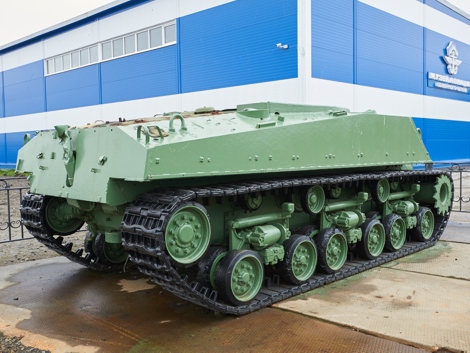
The
M4A2(76)HVSS shown above is thought to have been demilitarized and
converted to a turretless tractor shortly after WW II. It is on display
at the Safonovo Museum, alongside the M4A2(76)VVSS recovered from the
Thomas Donaldson. It has been reported as being Serial Number 64669,
which would indicate February, 1945 acceptance. A hole was cut in the
armor in front of the driver’s position, most likely as part of the
demilitarization process. With the removal of the turret, a blank off
plate with crude hatch was added to cover the opening. The exhaust
system appears to have been modified somewhat. Note the hole cut in the
upper rear hull plate, presumably to accommodate a new exhaust outlet.
Photos courtesy of Dmitry Ukryukov.

In September, 1945, it was
reported that there were 704 M4A2(76)s on hand at Depots in the US. Presumably,
these would have been almost entirely unassigned HVSS units from the last
months of production. Another 133 had been set aside for "conversions and
tests." The photo above shows Serial Number 65132 / USA 30123111 which
would have been accepted in April, 1945. The complete canvas mantlet cover
appears to have been introduced into production around March, 1945. However,
note that this is the less complex, original version as seen installed on the
76 mm pilot turret. We believe Fisher quickly replaced this version with the
standard or final mantlet cover configuration which can be seen on the May
production M4A2(76) in the following caption. For future reference, notice that
the smoke mortar cap (1) does NOT have a retaining chain, and that there is
something different about the middle bogie unit (2).

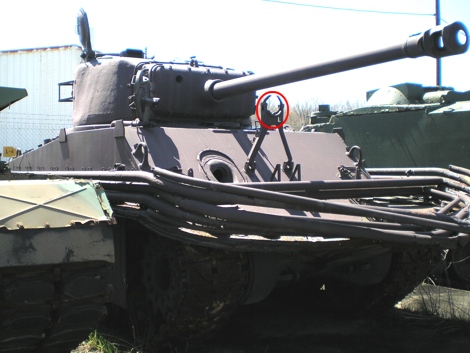
We suspect that most or all of the 133 M4A2(76)s listed in the US
Inventory as "conversions and tests" were set aside as part of the
200 DD swimming tanks that the US agreed to convert for the British as part of
their 1945 Lend Lease requirements. As it turned out, only the two pilot models
were completed before the project was terminated. One of the pilots was ordered
sent to the APG Ordnance Museum for "historic purposes." We recorded
the serial number as 69278, indicating May 1945 acceptance, the final month of
M4A2(76) production. Even at this late date, the gun travel lock is
"still" in the original "two fingers" configuration (circled in red.) Early
on, this was found to be unstable, but the one piece wrap-around replacement
that can be seen on many surviving Shermans must have been introduced into
production either very late or not at all. The Ordnance Department photo on
the left is dated August 2, 1945.


Correspondence dated September 1945 indicated that the British wanted
the other DD pilot (Sherman III AY DD III in British nomenclature),
"providing there will be no cost to the British public." It was not
given away, and later the British mocked up a DD using T224877 (above
left), one of the 5 M4A2(76)s they had received as Lend Lease in 1945.
Earlier, we pointed out the triangular shaped object which is noted on
both of the engine access doors. The APG DD pilot is one of perhaps four
surviving large hatch M4A2s that still has the original parts intact as
shown on the right. These are seen with a pair of clamps next to them,
and our correspondent, Dave Hobbs, was able to snap the triangle into
one of the clamps demonstrating that it may have been used to secure the
object during travel. These appear to have served as pulls to open and
close a series of shutters in a box mounted on the underside of the
engine deck doors. We
think the shutters were introduced in new M4A2 production sometime in
early 1944, possibly as part of a "Winterization Kit" modification for
Soviet Lend Lease. Thus, we theorize that they would have been on some
of the last large hatch M4A2(75)s and all of the M4A2(76)s.

As far as we can tell,
a late production M4A2 Technical Manual was never produced. The
illustrations above are from the July 1945 M36B2 Tank Destroyer TM and
show the "Engine Compartment Door Shutters" (highlighted in red) in the
drawing on the left. This actually appears to be an illustration of an
M4A2 hull with armored exhaust deflector. The image on the right
shows what we take to be the lever (arrow) that opened and closed the
shutters. This lever appears to have been connected to the triangular
pulls on the exterior door panels.


On
the left is a photo of the original interior configuration of one of
the engine deck doors as seen on M4A2(75) SN 9882 on display at
the Australian Army Tank Museum in Puckapunyal. Erik Albertson at "WW2
Armor" in Florida was kind enough to have a look at the interior of one
of the doors on their M4A2(76)HVSS and provide the photo on the right.
He commented that, "The [triangular] handle is missing on ours, but we
experimented to see if it opened and closed the vent to which it did."
Looking at Erik's photos, the "shutter box" strikes us as a "cassette"
that was bolted to the door right over the original configuration.

 In 1946, Canada is reported to have purchased 300 M4A2(76)s with HVSS
from the US at the very reasonable price of $1,460.00 each. However, the
"Canadian Arms and Armour" website has it that "It appears that
the final number of tanks delivered to Canada differed slightly from the
initial order, with 294 tanks being received at Long Point depot in
late 1946." These remained in Canada, where they were used as training
tanks. (The US Army provided Canadian forces in Korea with
M4A3(76)HVSS's.) The M4A2s were given DND (Department of National
Defence) CFR (Canadian Forces Registration) Numbers, and Canadian Arms
and Armour lists 292 of them running from 78-693 through 78-992.
Furthermore, the site lists the US Ordnance Serial Numbers of 63 units,
most of which have survived and are on display as museum pieces and
monuments throughout Canada. From our own Serial Number research
regarding the Canadian M4A2(76)s, we would observe that the data
indicates that they were built from March through May 1945. The example
shown above is Serial Number 69132 (April 1945 acceptance) and is on
display in Kelowna, British Columbia. The armored first aid box (circled
in red) appears on some but not all of the Canadian Shermans. Our
"counting heads" method suggests that the last 400 or so M4A2(76)s had
the first aid box factory installed. 69537 was the serial number of the
last M4A2(76) made. 69132 and those we have recorded with higher serial
numbers have the box (or telltale weld scars), but units recorded with
lower SNs do not. Photos courtesy of Alf Adams.
In 1946, Canada is reported to have purchased 300 M4A2(76)s with HVSS
from the US at the very reasonable price of $1,460.00 each. However, the
"Canadian Arms and Armour" website has it that "It appears that
the final number of tanks delivered to Canada differed slightly from the
initial order, with 294 tanks being received at Long Point depot in
late 1946." These remained in Canada, where they were used as training
tanks. (The US Army provided Canadian forces in Korea with
M4A3(76)HVSS's.) The M4A2s were given DND (Department of National
Defence) CFR (Canadian Forces Registration) Numbers, and Canadian Arms
and Armour lists 292 of them running from 78-693 through 78-992.
Furthermore, the site lists the US Ordnance Serial Numbers of 63 units,
most of which have survived and are on display as museum pieces and
monuments throughout Canada. From our own Serial Number research
regarding the Canadian M4A2(76)s, we would observe that the data
indicates that they were built from March through May 1945. The example
shown above is Serial Number 69132 (April 1945 acceptance) and is on
display in Kelowna, British Columbia. The armored first aid box (circled
in red) appears on some but not all of the Canadian Shermans. Our
"counting heads" method suggests that the last 400 or so M4A2(76)s had
the first aid box factory installed. 69537 was the serial number of the
last M4A2(76) made. 69132 and those we have recorded with higher serial
numbers have the box (or telltale weld scars), but units recorded with
lower SNs do not. Photos courtesy of Alf Adams.
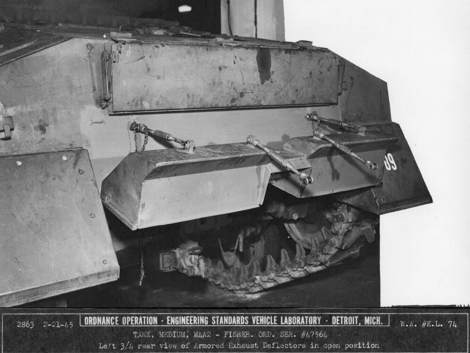
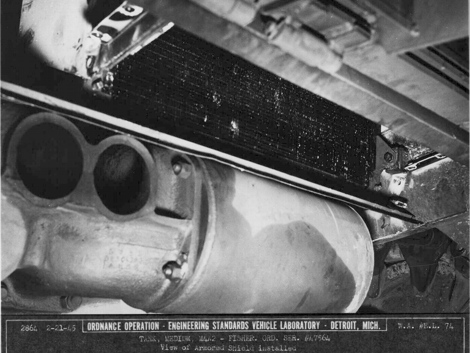
Reports
from the battlefield noted that the radiators of M4A2 and M4A3 Shermans were
vulnerable to shrapnel and other types of combat damage. In late 1944, the
Ordnance Department designed armored exhaust deflectors. We featured M4A2(75)
Serial Number 47564 earlier. In February 1945, it was used to "model"
the new deflector for the M4A2. As an additional part of the protection, an
armored shield replaced the earlier sheet metal piece over the exhaust outlet
and resonators, as seen in the right side photo. All of the surviving Canadian
M4A2(76)s have the armored deflectors (or the hinge fittings), which would lead
us to conclude that Fisher completed the transition to these in March 1945. This
would have been too late for very many of them to have been shipped overseas
during WW II.

Serial
Number 47564 was used again as a demonstration model in the updated version
(July 1945) of the Deep Water Fording Technical Manual. Note that the manual
included provision for sealing in the cordage of the new RC-298 Interphone
Extension Kit. This was produced too late for WW II, but can be seen on many
surviving Shermans. The absence of the box (or weld scars), suggests that the
phone was not installed on the 300 Canadian Shermans.

Another bit of minutia we have
noticed concerns the 2 inch smoke mortar. At the request of the British, this
was installed on Shermans starting in the Fall of 1943. It was even considered
"Urgent" (although not "Essential") to have it installed on
the 1397 M4 and M4A1 tanks in the US Pool in the UK before D-Day. However, it
was not popular with the troops who considered the mortar gun to be "in
the way" inside the cramped turret. They preferred to fire smoke from the
main gun. In the Pacific campaigns, where Japanese infantry would often swarm
over buttoned up Shermans, it was noted that they would try to drop grenades or
other explosives down the smoke mortar barrel. The Marines reported that they
fashioned wooden plugs to prevent this. In January 1945, the Ordnance Department
"got the message," and eliminated the smoke mortar from the Sherman.



Author
Yuri Pasholok recently examined a document from the Russian Archives
written by Lieutenant Colonel Pulnikov, Chief of the Tank Department of
the Soviet Purchasing Commission (SPKZ) in the US. Pulnikov’s report is
dated March 13th, 1945, and in it he described some of the changes that
had been made to the M4A2(76). This information was no doubt provided to
him by representatives of Fisher Body. One such change was that the
"eliminate the smoke mortar" directive was reported to have been
implemented by Fisher at “Tank # 64741” (February 1945 production).
Earlier, we discussed the transitional nature of the introduction of
most changes. We suspect that "eliminate the smoke mortar" was a hard
change. That is, there was no transition, and that Fisher stopped
installing the smoke mortar shortly after they received the directive
from the Ordnance Department. Any remaining supplies of mortars,
ammunition and fittings simply became obsolete. An examination of the
surviving Canadian M4A2(76)s suggests a sort of “smoke mortar hole”
chronology. Those turrets already prepared with the protruding sleeve
and cap installed, simply had the cap welded on, and thus there was no
need for the cap's retaining chain. Those turrets made with the mortar
hole already bored out, had a square of armor welded over it. And
finally, the APG DD pilot and many of the Canadian Shermans can be seen
to have clean, "un-holed" turrets.


All of the surviving Canadian
M4A2(76)s have mantlet cover fittings, but they are seen in two configurations.
The first or early configuration is shown on Serial Number 65017 (above left)
in Goderich, Ontario. "Counting heads" suggests that this was
introduced in March 1945, and was installed on approximately 520 units, before
being replaced with the second type around mid April. At present, Serial Number
69059 (above right) on display in Olds, Alberta Province, Canada is
"patient zero" for the second type mantlet cover. That is, all of the
surviving examples with lower serial numbers have been noted with the first
type, while all with higher serial numbers have what we would consider the
"standard" mantlet cover. Note the large number of fittings required
for this much more elaborate installation. No doubt the extra effort and
expense made for a more watertight cover. Our "head count" suggests
that the standard type would have been installed on approximately the last 480
units accepted in April and May 1945. Only Fisher M4A2(76)HVSS units appear to
have employed the first type. Chrysler and Pressed Steel Car are thought to
have used only the standard type in production. Additionally, most surviving
M4A1(76) and M4A3(76) Shermans are equipped with the standard type mantlet
cover, which suggests that a large number of modification kits were provided
for the various post war M4A1(76) and M4A3(76) remanufacturing programs.


Foundry
casting capacity was limited, and early on, Fisher Body was tasked with
designing alternatives to the Sherman's many cast components. The
welded together drivers' hoods introduced
on Fisher M4A2(75)s in late 1942, are the most conspicuous examples of
the use of alternate parts. Fabricated HVSS suspension arms can be seen
mixed in with the usual cast "bogie arms" on many of the Canadian
M4A2(76)s. The cast arms have been noted to be Part Numbers D80066 A or
B.
A few examples of the fabricated arms have been observed with "7028976" stamped into them, which we take to be the part number. According to a Tank Arsenal Proving Ground Report dated 9
May 1945, they were designed "by the Fisher Tank Division as
alternatives for the standard cast steel arms to alleviate a critical
casting situation. They were fabricated from two-inch armor plate with
the spring seat pin, gudgeon pin, and bogie wheel shaft bosses cast and
welded into place." Compared to the cast suspension arms (right)
originally designed by Chrysler, all of the fabricated arms we have
seen have "void lightening holes." For improved strength, the TAPG
Report recommended that the holes be eliminated, and reinforcing ribs
be added, but if these revisions were ever made before the end of
Sherman production, we have not as yet come across an example. In any
case, we would guess that, starting around March 1945, Fisher mixed
these in, one to a side, with the cast type. The fabricated units may
have been mounted in the center, as seen in the APG photo of Serial
Number 65132 shown earlier. These can be spotted on a few surviving
M4A1(76)s as well.
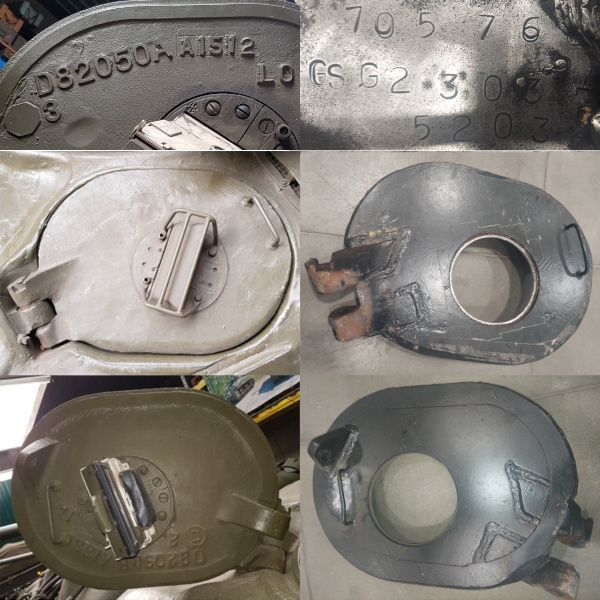
Throughout Sherman production, drivers’ hatches, both large and small,
were produced as castings (left side photos). However, a few fabricated
hatches have been observed on a small number of the surviving M4A2(76)s
in Canada and Russia. In addition, the hatch shown above on the right is
from an ex Canadian M4A2(76) on display at the National Museum of
Military Vehicles in Dubois, Wyoming. Note how the hinges, which we
believe were forged, not cast, are welded into the body of the hatch.
The part numbers observed on the cast hatches such as the one on the
left, are D82050A for the driver’s hatch, and D82050B for the bow
gunner’s. The fabricated hatches would have had part numbers stamped
into the plates, and Mark Sellnow of the Tank Restoration Shop at the
NMMV was kind enough to provide us with some photos of the bow gunner's
hatch. The inset shows the stampings Mark found on the inside surface under the lifting handle. Our interpretation is
that the Part Number of the hatch is on the top line. It is only a
partial number, 70576, since the final number along with a B suffix were
"overwritten" by the welded-on piece. Fisher got its armor plate from a
consortium of suppliers headed by Standard Steel Spring Company. On the
second line, we think that the "GS" stands for General Steel and Bumper
Co. who were the heat treaters, and the "G" stands for Great Lakes
Steel, who were the source of the steel. "2303" would be the heat
treatment number and the number on the bottom line was probably the lot
or serial number of the piece. If there is not too much paint, similar
stampings can be observed on most pieces of armor plate on Shermans. In
any case, a guess is that these fabricated hatches were installed on
some of the Shermans built by Fisher starting in late 1944 through to
the end of production.

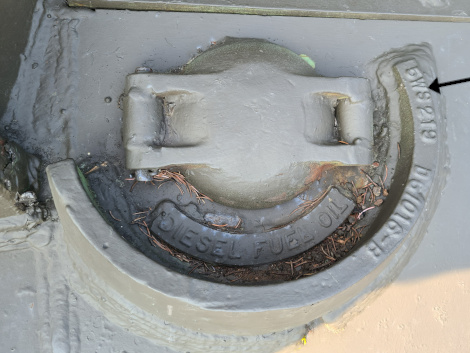 Another fabricated component that appears to have been used by Fisher
alone is the bullet splash that protected the armored fuel filler caps.
Just from observation of surviving Fisher Shermans, we think that they
were introduced at the beginning of 1945 for use on their remaining
production of M4A2(76)s and M4A3(75)s. The photo on the left shows an
example of a fabricated bullet splash on SN 65042 in Sarnia, Ontario
Province. The sun was hitting it just right, making it easy to read the
Part Number "D51016-A" which is the same PN as used on the cast
component. The "A" suffix indicates the piece for the right side of the
tank. The left side was simply a mirror image with PN "D51016-B." The
fabrications are a bit thicker than the castings and have a strictly
vertical orientation. These don't appear to have completely replaced the
castings, but we can observe that they are on the vast majority of the
M4A2(76)s we have had the opportunity to inspect in Canada. SN 65009 in
Moncton, New Brunswick was built with the cast parts, and the photo on
the right shows its "D51016-B" part number cast into the top edge of the
piece. The "WS" (arrow) seen here might be the caster's logo of
Wehr Steel of Milwaukee. Note that the castings have a slight inward
angle to them. SN 65076 in Sudbury, Ontario actually has a mix with a casting
on the right side and a fabricated piece on the left.
Another fabricated component that appears to have been used by Fisher
alone is the bullet splash that protected the armored fuel filler caps.
Just from observation of surviving Fisher Shermans, we think that they
were introduced at the beginning of 1945 for use on their remaining
production of M4A2(76)s and M4A3(75)s. The photo on the left shows an
example of a fabricated bullet splash on SN 65042 in Sarnia, Ontario
Province. The sun was hitting it just right, making it easy to read the
Part Number "D51016-A" which is the same PN as used on the cast
component. The "A" suffix indicates the piece for the right side of the
tank. The left side was simply a mirror image with PN "D51016-B." The
fabrications are a bit thicker than the castings and have a strictly
vertical orientation. These don't appear to have completely replaced the
castings, but we can observe that they are on the vast majority of the
M4A2(76)s we have had the opportunity to inspect in Canada. SN 65009 in
Moncton, New Brunswick was built with the cast parts, and the photo on
the right shows its "D51016-B" part number cast into the top edge of the
piece. The "WS" (arrow) seen here might be the caster's logo of
Wehr Steel of Milwaukee. Note that the castings have a slight inward
angle to them. SN 65076 in Sudbury, Ontario actually has a mix with a casting
on the right side and a fabricated piece on the left.

At
first, Fisher Body was contracted to produce all of the M4A2(76)s, but in
October 1944, 150 units were subtracted from their Production Order. A
"token" order was placed with Pressed Steel Car in order to keep the
workers on the job in 1945 "to enable them to produce in quantity in a
short time should conditions require volume production." The planners had
to assume that the war with Japan might drag on for years, but as it turned
out, further production was unnecessary, and PSC produced only 21 M4A2(76)s
before their contract was terminated. A similar “token” order was apparently
placed with Montreal Locomotive Works, as a Memorandum dated March 28, 1945,
and entitled “Tank Production in Canada on U.S. Account” states that “The United
States has ordered 579 Medium Tanks M4-A2 which will mount 76MM Guns.” Obviously
this contract was terminated before any of these were built. The photo above
shows one of the units made by Pressed Steel Car. This tank can be seen with
casting numbers on the turret typical of Union Steel (1), the primary turret
supplier to PSC, but not Fisher Body. The M3 type of drive sprocket (2)
seen here appears to have been reintroduced at PSC in 1945, but not at Fisher.
The few photos of Soviet M4A2(76)HVSS show them with the earlier T66 type
tracks. Here one can see the superior T80 track (3). Pressed Steel and Fisher
are reported to have received deliveries of both T-66 and T-80 tracks in
February 1945. In the following months, all deliveries were reported to be
T-80. While there are about 70 surviving M4A2(76)HVSS's in North America, to
date, none have been identified as PSC. Photo courtesy of Kenneth Nielsen -
Pressed Steel !

After the Canadian sale, 529 M4A2(76)HVSS
are reported to have been left in the US inventory. These were used as
"parts junkers" in the late 1940s /early 1950s. That is, their turrets,
suspensions and other useful components were removed, and used to convert many
of the remaining M4A3(75)Wets in the inventory to M4A3(76)HVSS. The M4A2(76)HVSS shown above
can be seen to be USA 30129692 S, indicating April 1945 acceptance. (The
"S" often seen at the end of US Army Registration Numbers is
frequently mistaken for a "5," but it signifies that the vehicle was
equipped with a Radio Interference Suppression System.) This photo is from a
souvenir history of the Letterkenny Ordnance Depot, and most likely depicts
such a salvage operation.


 The authors have noticed that
all surviving Fisher built, large hatch Shermans we have examined have a series
of weld beads mostly horizontal, but some vertical, that were applied to fill
in the differential housing bolt strip overcut. We consider this a Fisher
recognition feature, since all examples of Chryslers seen used a half round
piece welded in to fill in the overcut. It is to be noted that the differential housing bolt strip overcut is "open" in the single photo of a known PSC
M4A2(76).
The authors have noticed that
all surviving Fisher built, large hatch Shermans we have examined have a series
of weld beads mostly horizontal, but some vertical, that were applied to fill
in the differential housing bolt strip overcut. We consider this a Fisher
recognition feature, since all examples of Chryslers seen used a half round
piece welded in to fill in the overcut. It is to be noted that the differential housing bolt strip overcut is "open" in the single photo of a known PSC
M4A2(76).
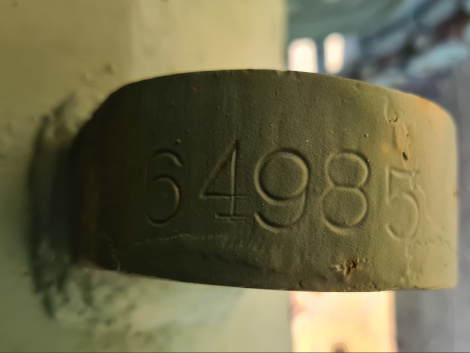
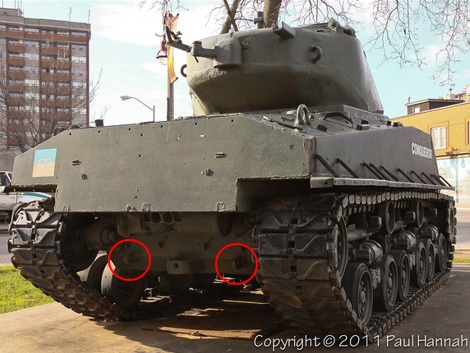
Fisher and Chrysler built Shermans have the Tank's Ordnance Serial Number stamped into the rear towing lugs.
On the other hand, Pressed Steel Car
does not appear to have stamped the Serial Number anywhere on
the exterior of the AFVs they produced.

Starting
in July 1943 with the introduction of the late, sharp-nosed E8543
differential housings, Fisher began to stamp the tank's Ordnance Serial
Number on both edges of the differential housing. The diff stamping is
preceded by an "S" prefix, presumably for "Serial Number", as can be
seen above on S64985 on display at Camp Borden in Ontario. Of course, on
some surviving Fisher Shermans, the serial number on the diff is not
the same as that found on the dataplate or rear towing lugs. This would
indicate that the original differential housing was replaced.
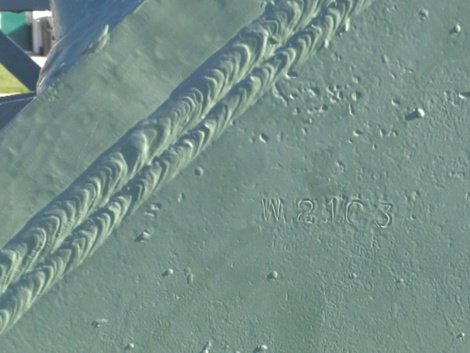

Fisher built Shermans have been seen
to have a loose build sequence number stamped on the left front
(driver's side). On Second Generation Fishers, these numbers have a
letter prefix. The "W" seen stamped in front of 2103 on the left above
indicates it was built as an M4A2(76). Again, this was recorded from
M4A2(76)HVSS Serial Number 64985 on display at Camp Borden. Other
letters noted are "E" for M4A3E2 (Jumbo), "M" for M4A3(76) and "A" for
M4A3(75)W. This "side number" can be useful in the event the tank's
serial number can't be found. In cases where there is not a lot of
paint build-up, the same "side number" has been observed stamped on the
rear most engine deck door hinges of some M4A2(76)s as shown on the
right. Of course, there have been instances where the numbers on the
engine deck door hinges do not match the "side number", and we assume
that, in those cases, the engine deck doors may have been replaced.



